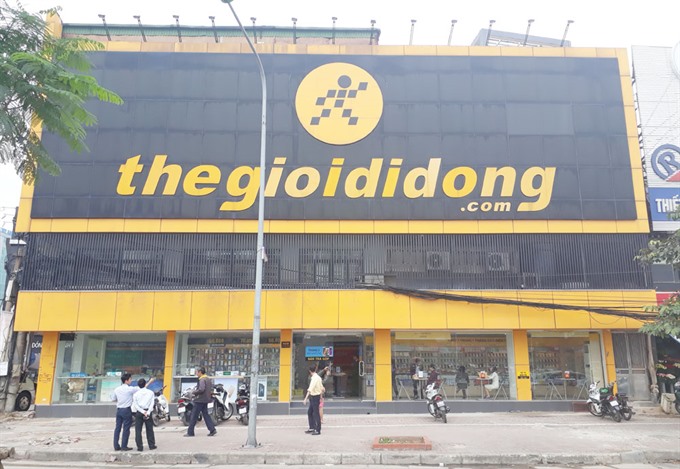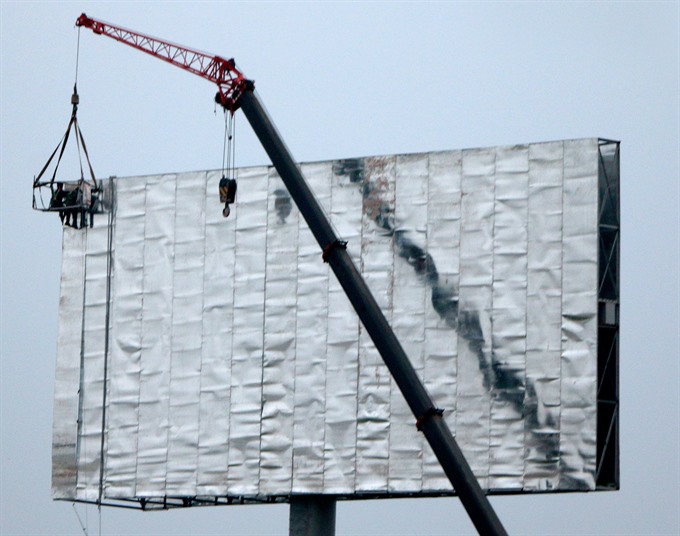 Society
Society

Oversized billboards of popular brands have popped up prominently in the capital city for a long time now. However, successful removal of these unwished-for and illegal ‘sky debris’ depends not only on a more committed enforcement, but also on these companies’ inclination to follow regulations.
 |
| Store sign featured on many of Thế Giới Di Động (Mobile World) stores like this one on Lê Duẩn Street are larger than what the law permits, however, the practice has gone on unpunished. — Photo kinhtedothi.vn |
HÀ NỘI – Oversized billboards featuring popular brands have been common in Hà Nội for a long time now. However, removing these illegal billboards is trickier than erecting them, needing committed enforcement and companies to follow regulations.
The large signs that cover the front and sometimes also the sides of a building pose a legitimate fire concern. Firefighting forces said the panels block possible exits for those inside buildings should fire occur. Also, as they are made from highly inflammable materials such as styrofoam or plastic and furnished with lighting systems, they can cause fires.
The lesson of last year’s devastating fire that destroyed a karaoke bar and killed 13 remains raw and the tragedy began with an overbearing store sign that covered the front of the eight-storey building and went up in flames after an electrical malfunction.
Throughout the city, it’s hard not to notice ubiquitous and large black boards with the words thegioididong.com (roughly translated as Mobile World) in yellow.
Owned by Mobile World Investment Corporation, Thế Giới Di Động chain specialising in consumer electronics is a household name. Their store signs are conspicuous, and so are their violations.
According to the Ministry of Construction’s regulations, the total area of a front-facing store sign must not exceed 20 sqr.m, however, the sign panel of the Thế Giới Di Động store located at 470-472 Lê Duẩn stretched upwards of 120 sqr.m, six times above the limit. Independent billboards (not attached to buildings) usually found on highways must not be bigger than 120 sqr.m, but Thế Giới Di Động’s billboards measure 130-150 sqr.m.
Bùi Minh Hoàng, head of the culture management office under the municipal Department of Culture, said that metal-frame advertisement board or store signs over 20 sqr.m on buildings are only legal with a permit from authorities.
“However, none of the stores belonging to this brand can produce such permissions,” Hoàng added.
Similarly, the Thế Giới Di Động on Đại La Street, Hai Bà Trưng District, stretches dozens of metres in width and is at least five metres high, vastly over the limit.
Perhaps most egregiously, in the outlying district of Thanh Trì, a Thế Giới Di Động store featuring a 100 sqr.m sign towers near the headquarters of the district’s People’s Committee.
Article 34 of the Law on Advertising (2012) says that signs must contain information regarding its owners, however, the brand’s signs contain only the website of the company plus its logo.
“The company has made systematic and flagrant violations not only in the city, but also in other provinces,” Hoàng said.
According to Hoàng, these violations from a well-known brand indirectly led to more companies doing the same, thinking that this practice would go unpunished.
Cleanup campaign soon commenced
As an extension of the ‘sidewalk cleanup campaign’ currently underway in cities throughout the country, the capital city’s authorities are planning a similar scheme to tackle illegal billboards.
In reality, these oversized and garish advertising boards weren’t erected unnoticed.
The management of billboards on buildings is delegated to local governments (wards and district-level). However, as far as accountability is concerned, a recent inter-sectoral campaign to get rid of billboards in Đống Đa District shone a light on this murky subject.
The local construction department said it wasn’t their job, but the culture department’s responsibility, however, the culture department can only demolish offending boards, but the buildings the boards are on are within the construction department’s jurisdiction.
Nguyễn Duy Tuấn, Department of Culture and Communications of the outlying Thanh Trì District said local officials “have only been able to meet with the employees, never the owners [of Thế Giới Di Động]” so “not one violation has been corrected.”
In addition, under law, the highest fine for each illegal billboard is a paltry VNĐ 10 million (US$440).
In 2016, the municipal People’s Committee took down some 190 billboards that weren’t attached to buildings. Võ Nguyên Giáp street, for example, is no longer cluttered with panels that obstruct drivers’ vision. This was not an easy task considering the resistance from offenders, ranging from litigation threats, small protests and harassment directed against officials.
Chairman of Hà Nội People’s Committee Nguyễn Đức Chung has directed competent agencies to tackle oversized storefront signs next.
“The culture department does not have enough manpower to list and handle all the storefront signs. An inter-sectoral task force has been established to take an inventory of all billboards and offending signs in the city by the end of April,” Bùi Minh Hoàng, head of culture management, said.
“Once the violating cases have been identified, reminders will be issued to local governments to ‘take care’ of the signs and a report will be compiled to submit to higher-ups for further guidance,” he added.
It remains to be seen whether authorities’ renewed efforts will produce fruitful results, but targeting transgressions is a good first step. – VNS
 |
| Biển quảng cáo quá khổ gây nguy hiểm cho người tham gia giao thông. VNS Photo Đoàn Tùng |









